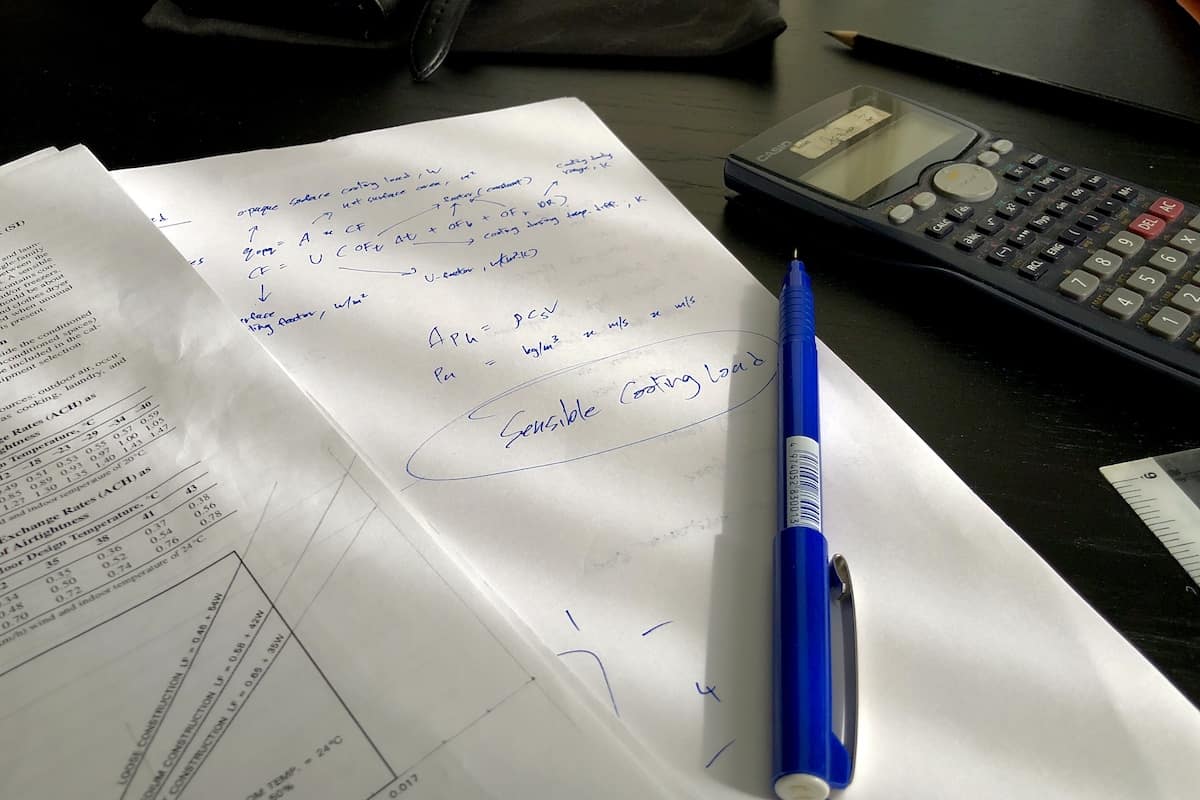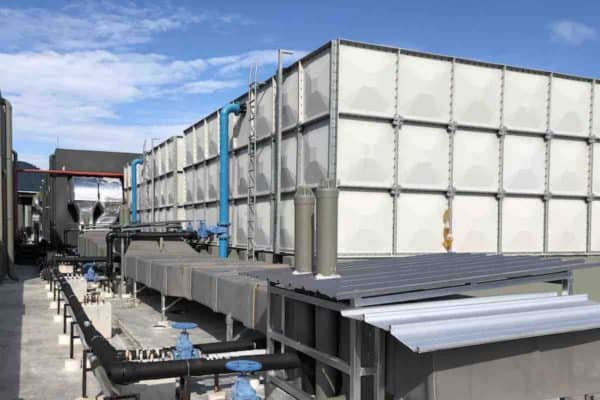Cooling Load Calculation Guide (Methods & Examples)
Cooling load calculation is one the most challenging yet mysterious things in the HVAC industry. Most engineers use a rule of thumb to size air conditioners but, what are the other so-called proper way to do cooling load calculations?
Generally, most engineers perform cooling load calculations using the Rule of Thumb. Meanwhile, many HVAC companies use software tools such as Manual J and Wrightsoft to conduct cooling load calculations. Only a handful of engineers know how to calculate cooling load manually.
Although software tools provide more accurate results, they mostly require detailed inputs which most people and even engineers don’t have or are unable to get their hands on.
How to Calculate Cooling Load?
Cooling load calculation is the most mysterious thing for me as an HVAC engineer. Other HVAC calculations like chilled water pipe sizing, grille sizing and pressurization fan sizing are learnable from my seniors and managers. But, when it comes to proper cooling load calculation, they have no idea too.
What I mean by proper cooling load calculation is that the calculation is not done by using the Rule of Thumb. Most engineers and even reputable consulting firms are using Rule of Thumb to estimate the required cooling load of both residential and commercial buildings.
Rule of Thumb
In Malaysia, the standard Rule of Thumb is 60 btu/hr/sqft for standard rooms such as the bedroom, living room and office space. For large halls, the standard Rule of Thumb is 120 btu/hr.sqft. Other Rule of Thumb figures as the below table:
| Application | Rule of Thumb (btu/hr/sqft) |
|---|---|
| Apartments | 60 |
| Auditoriums, Theaters | 120 |
| Classrooms | 80 |
| Laboratories | 75 |
| Cafeteria, Coffee House | 110 |
| Factories | 120 |
| Laboratories | 100 |
| Libraries | 70 |
| Clinics | 80 |
| Office Rooms | 90 |
| Conference Rooms | 120 |
| Restaurants | 120 |
| Shopping Centers | 65 |
So, when Rule of Thumb is used to estimate the cooling load required for a 150 sqft bedroom, the result is 9000 btu/hr or 1 horsepower or other measurement units.
Personally, I don’t see Rule of Thumb as a bad practice. However, it needs to be used by experienced engineers. After all, it is developed by experienced engineers over time to get things done quicker. Furthermore, it has been proven to be useful by reputable consulting firms.
In other words, the air conditioners in your house and office may be sized with Rule of Thumb. Do they work well?
Nevertheless, we need to understand the fundamentals of cooling load calculation so that we know how Rule of Thumb works and thus, how to apply it correctly.
So, let’s take a look at one of the cooling load calculation methods suggested by ASHRAE.
By the way, you can speed up your design calculation process with my HVAC excel calculators. They are great for basic sizing and design. However, if you’re a design engineer, I encourage you to learn cooling load calculation as it is an extremely valuable skill to have.
RTS Cooling Load Calculation Course
Learn how to calculate cooling load using the ASHRAE’s Radiant Time Series method that accounts for solar heat gain, conductive heat gain, radiant heat gain and internal heat gain in a 24 hours load profile manner.
ASHRAE CLTD Cooling Load Calculation
There are a few methods suggested by ASHRAE to calculate the cooling load. Some are extremely complicated and require a computer or programming to perform the calculation which, we don’t want to get into them now.
So, I’ve digested the residential cooling load calculation suggested by ASHRAE. It is a manual way to calculate the cooling load. To be frank, it is quite complicated as well.
ASHRAE residential cooling load calculation can be broken into 7 parts for the following:
- Windows
- Doors
- Walls
- Ceilings
- Infiltration
- People, lights and appliances
- Latent load
After that, I’ll personally add in another three steps to consider duct loss, an outdoor air system and a safety factor. So, it’ll be a total of 10 steps to calculate the cooling load for a room.
It may look hard to learn but hang on, the following is the step-by-step on how to calculate the cooling load.
1. Windows Sensible Cooling Load Calculation
The sensible cooling load of windows is calculated by multiplying the area of the windows by the glass load factor (GLF). The formula used is as follow:
q = Aw(GLF)
where,
q = sensible cooling load, W
A = area of window, m2
GLF = glass load factor, W/m2
The glass load factors of various windows and their shading types are outlined in the ASHRAE Handbook of Fundamentals 2001. However, new versions like the 2021 ASHRAE Handbook and 2017 ASHRAE Handbook on Amazon have different values and additional procedures.
Nevertheless, just follow through this article to understand the basic procedures first.
Windows glass load factor is affected by the orientation of the windows (eg: north, south, east, west). But, the most important design parameter is the outdoor temperature.
To calculate windows and other sensible cooling loads, you need to decide the outdoor temperature first. For example, in Malaysia, we usually design at an outdoor temperature of 35°C.
You can decide the outdoor temperature based on your practices or find out the average outdoor temperature of your city from weather stations or climate websites like timeanddate.
Calculation Example
Now, I’ll walk you through the calculation using my bedroom as the example for the entire cooling load calculation. The below is my bedroom layout drawing and windows detail:
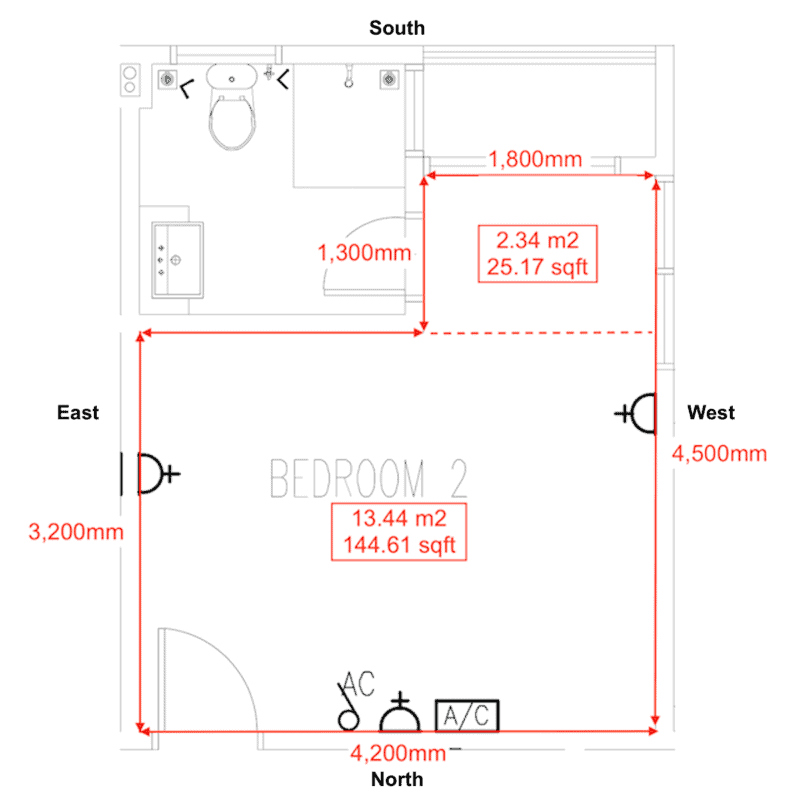
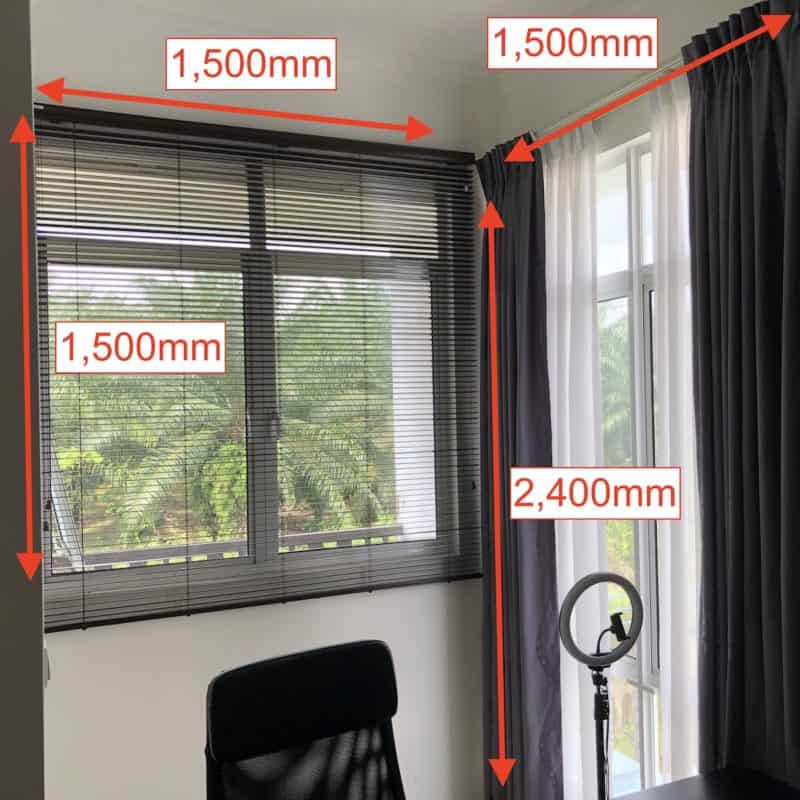
My bedroom has two windows. The area of my windows is 2.25 m2 for the one facing south and 3.6 m2 for the big one that is facing west.
From the ASHRAE glass load factor table, a regular single glass at 35°C design temperature with shading is 104 W/m2 for the south window and 158 W/m2 for the west window.
Using the window sensible cooling load formula:
q = A(GLF)
q = (2.25 x 104) + (3.6 x 158)
q = 802.80 W
Therefore, the sensible cooling load of the windows in my bedroom is 802.80 W. Now, let’s proceed to calculate the sensible cooling load for doors.
2. Doors Sensible Cooling Load Calculation
The sensible cooling load of doors is calculated by multiplying the area of the doors by the U-factor of the doors and the cooling load temperature difference (CLTD). The formula used is as follow:
q = AdUd(CLTD)
where,
q = sensible cooling load, W
Ad = area of door, m2
Ud = door U-factor, W/(m2.K)
CLTD = cooling load temperature difference, K
The cooling load temperature difference (CLTD) is again, available in the ASHRAE Handbook of Fundamentals 2001. Again, other versions may have different values. However, the door U-factor is not included.
Therefore, you need to find out the door U-factor which is depending on the door type and the material used to construct the door. To simplify things, I use a standard 1.82 W/(m2.K) for my bedroom door sensible cooling load calculation.
Calculation Example (cont.)
Similar to windows, the orientation of doors and the outdoor temperature are the two parameters that affect the CLTD. Below is my bedroom layout drawing again and doors detail.
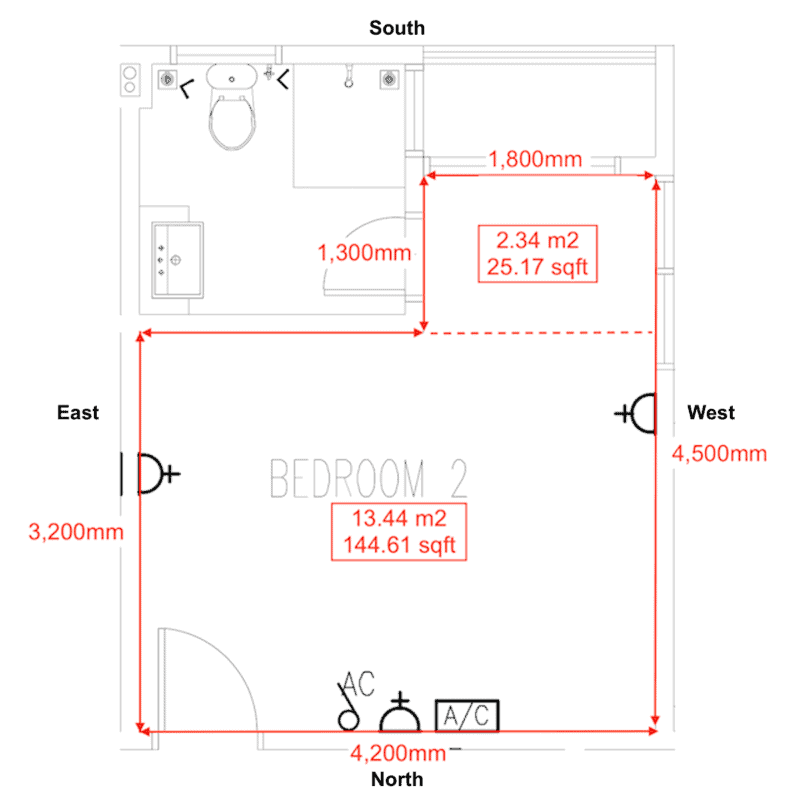
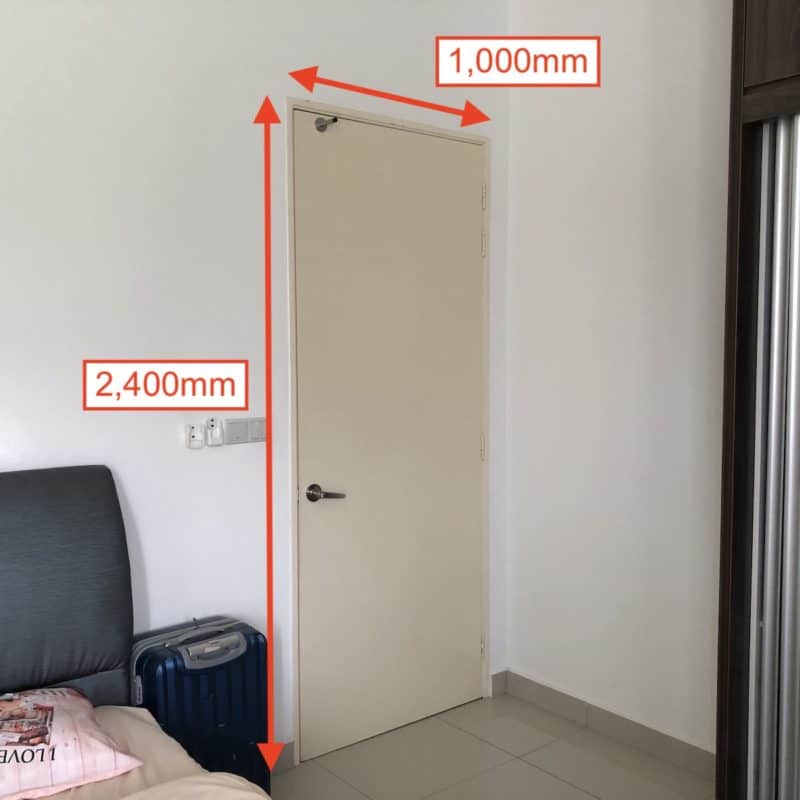
My bedroom has two doors; one for the entrance and the other one for the toilet. The area of each door is 2.4 m2 with one facing north and the other one facing east.
Based on the ASHRAE CLTD data, the north door has a CLTD of 7 K while the east door has a CLTD of 13 K.
Using the door sensible cooling load formula:
q = AdUd(CLTD)
q = (2.4 x 1.82 x 7) + (2.4 x 1.82 x 13)
q = 87.36 W
Therefore, the sensible cooling load of the doors in my bedroom is 87.36 W. Now, let’s proceed to calculate the sensible cooling load for walls.
3. Walls Sensible Cooling Load Calculation
The sensible cooling load of walls is calculated by multiplying the area of the wall by the U-factor of the walls and the cooling load temperature difference (CLTD). The formula used is as follow:
q = AwUw(CLTD)
where,
q = sensible cooling load, W
Aw = area of wall, m2
Uw = door U-factor, W/(m2.K)
CLTD = cooling load temperature difference, K
The cooling load temperature difference (CLTD) is once again, available in the ASHRAE Handbook of Fundamentals 2001. And once again, other versions may have different values and the wall U-factor is not included.
Therefore, again, you need to find out the wall U-factor which is depending on the wall type and the material used to construct the wall. To make it less complicated, I use a typical 2 W/(m2.K) as the U-factor for all of the uninsulated walls of my bedroom. For insulated walls, you can use 0.34 W/(m2.K).
Moreover, I’m assuming that adjacent rooms are unconditioned spaces and they are as hot as the outside temperature. In reality, adjacent rooms are mostly air-conditioned. So, the walls may not have any sensible cooling load at all.
Calculation Example (cont.)
Almost the same as the doors, the orientation of walls and the outdoor temperature are the two parameters that affect the CLTD. So, again, I’ll bring up my bedroom layout drawing.

Now, we need to calculate the area of wall facing each direction (north, south, east, west) and then multiply each of them by the U-factor and the CLTD. My bedroom has a ceiling height of 3 meters. So, here is the summary:
| Wall | Area | CLTD |
|---|---|---|
| North Wall | 10.2 m2 | 7 K |
| South Wall | 10.35 m2 | 9 K |
| East Wall | 11.1 m2 | 13 K |
| West Wall | 13.5 m2 | 13 K |
Using the wall sensible cooling load formula:
q = AwUw(CLTD)
q = (10.2 x 2 x 7) + (10.35 x 2 x 9) + (11.1 x 2 x 13) + (13.5 x 2 x 13)
q = 968.70 W
Therefore, the sensible cooling load of the doors in my bedroom is 968.70 W. If you have insulated walls, you’ll have a lower U-factor and thus, a lesser sensible cooling load. Now, let’s proceed to calculate the sensible cooling load for ceilings and floors.
4. Ceilings and Floors Sensible Cooling Load Calculation
The sensible cooling load of ceilings and floors is calculated by multiplying the area of the ceilings and floors by the U-factor of the ceilings and floors and the cooling load temperature difference (CLTD). The formula used for ceilings and floors is:
q = AcUc(CLTD) + AfUf(CLTD)
where,
q = sensible cooling load, W
Ac = area of ceiling, m2
Af = area of floor, m2
Uc = ceiling U-factor, W/(m2.K)
Uf = floor U-factor, W/(m2.K)
CLTD = cooling load temperature difference, K
The cooling load temperature difference (CLTD) is yet again, available in the ASHRAE Handbook of Fundamentals 2001. And again, other versions may have different values and the wall U-factor is not included.
Therefore, you need to find out the U-factor of ceilings and floors which are depending on the type and material used. For simplicity, I use a standard 0.28 W/(m2.K) for the U-factor of ceilings and 0.13 W/(m2.K) for the U-factor of floors.
Calculation Example (cont.)
Since my bedroom has a floor area of 13.44 sqft, I can immediately tell that the ceiling area is also 13.44 sqft which in my case, it is applicable.
For ceilings and floors, the orientation doesn’t matter, they don’t have any orientation anyway. So, from the ASHRAE CLTD table, my ceilings have a CLTD of 26 K and my floors have a CLTD of 7 K.
Using the ceilings and floors sensible cooling load formula:
q = AcUc(CLTD) + AfUf(CLTD)
q = (13.44 x 0.28 x 26) + (13.44 x 0.13 x 7)
q = 110.07 W
Therefore, the sensible cooling load of the ceilings and floors in my bedroom is 110.07 W. Now, let’s proceed to calculate the sensible cooling load for infiltration.
5. Infiltration Sensible Cooling Load Calculation
The sensible cooling load of infiltration is calculated by multiplying 1.2 by the specific heat of air, the air change rate, room volume and the difference between designed indoor and outdoor temperature. The formula used for infiltration is:
q = 1.2(ACH)(V)(to-ti)(1000/3600)
where,
q = sensible cooling load, W
ACH = air change per hour, l/h
V = volume of room, m3
to = outdoor temperature, °C
ti = indoor temperature, °C
The air change rate is basically about the airtightness of the room. In other words, how much air moving in and out of the room due to leakages such as door and window gaps.
ASHRAE included the suggested air change rate for winter and summer. Furthermore, the air change rate is affected by the outdoor temperature as well as the airtightness of the room.
If the room is tightly-sealed, you can use an air change rate of 0.35. If the room is mediumly-sealed, you can use an air change rate of 0.5. If the room is loosely-sealed, you can use an air change rate of 0.72.
The outdoor temperature was decided earlier and now, we need to decide the indoor temperature. Usually, we’ll use a typical 24°C of indoor temperature. The volume of room required no further elaboration.
Calculation Example (cont.)
My bedroom is relatively new room and the air leakages is minimal. Hence, I’ll use 0.35 as the air change rate. Using the infiltration sensible cooling load formula:
q = 1.2(ACH)(V)(to-ti)(1000/3600)
q = 1.2 x 0.35 x (13.44 x 3) x (35-24) x (1000/3600)
q = 51.74 W
Therefore, the sensible cooling load of the infiltration in my bedroom is 51.74 W. So far, all of the results are acceptable and make sense. Now, let’s proceed to calculate the sensible cooling load for people, lights and appliances.
6. People, Lights and Appliances Sensible Cooling Load Calculation
A normal person emits about 67 W or 228 btu/hr of heat energy while sitting down and using a computer. It is appropriate for the people in the bedroom. However, if you are working on other applications such as warehouses and workstations, you may need to increase that value.
Next, you need to estimate how many people are going to be in the room. Obviously, the greater the number of people, the greater the heat gain.
There are too many different lights and appliances in the world. While you can find each of them and check their wattage, it is too time-consuming. Hence, I use a general 250 W for all the lights and appliances in the bedroom. However, you also may need to increase the value for other applications.
Calculation Example (cont.)
Back to my bedroom, I use 1 person at 67 W of heat energy and 250 W for the total wattage of all lights and appliances in my bedroom. So, the total wattage is 317 W which is equivalent to the sensible cooling load of people, lights and appliances.
7. Latent Load Factor
We have completed the calculations for the sensible cooling load. Now, it’s time to calculate the latent cooling load and for it, ASHRAE uses the latent load factor to increase the load based on the airtightness of the construction.
The latent load factor is depending on the outdoor dry bulb and wet bulb temperature. We already have the outdoor dry bulb temperature which is 35°C. In Malaysia, we usually use 28°C for the wet bulb temperature.
With the Psychrometric Chart, we can determine the humidity ratio based on the outdoor dry bulb and wet bulb temperature which the result is about 0.02 kg/kg.
Using the McQuiston graph of latent load factor against humidity ratio which is available in ASHRAE Handbooks as well as publicly available on the internet, the latent load factor of a tightly-sealed room at about 0.02 kg/kg of humidity ratio is about 1.34.
Nevertheless, McQuiston also suggested that: “a latent load factor os 1.3 matches the performance of typical residential vapor compression cooling systems”.
However, it is depending on geographical location or climate. In North America, most homes have a cooling load of less than 1.3 latent load factor. Hence, you should always determine your own humidity ratio thereby determining the latent load factor.
Calculation Example (cont.)
Earlier, we’ve calculated multiple sensible cooling loads for my bedroom. Here is the summary:
| Sensible Cooling Load | Calculation Result |
|---|---|
| Windows | 802.80 W |
| Doors | 87.36 W |
| Walls | 968.70 W |
| Ceilings and Floors | 110.07 W |
| Infiltration | 51.74 W |
| People, Lights and Appliances | 317 W |
So, the total sensible cooling load is 2337.67 W.
To calculate the total cooling load, multiply the total sensible cooling load by the latent load factor. Thus, the total cooling load is 2337.67 W multiplied by 1.34 which is equal to 3132.47 W.
Usually, the cooling load calculation ends here. The final cooling load is 3132.47 W or 3.13 kW or 10688 btu/hr in which, the suitable air conditioner size is 12000 BTU or 3.5 kW or 1 Ton or 1.5 HP.
However, I would like to go further down to consider the introduction of the outdoor air system and duct losses as well as adding a safety factor to the overall cooling load calculation.
Other Considerations
The final cooling load of 3132.47 W did not account for any form of energy losses. If you are using a ducted air conditioner, there will be duct losses. Assuming a 5% duct loss, the final cooling load increases to 3289.11 W.
Furthermore, if additional outdoor air is introduced in a form of an outdoor air ventilation system, the air change rate at part 5 will increase and thus, the infiltration sensible cooling load will increase.
Let’s say the air change rate is raised to 0.5, the new infiltration sensible cooling load is 73.92 W as opposed to 51.74 W. Hence, the final cooling load increases again to 3320.31 W. Take note that you need to increase the sensible cooling load first before you add the 5% duct loss.
Lastly, we can consider adding a 5% safety factor to the final result. Therefore, the final cooling load is 3486.33 W or 3.49 kW or 11895 btu/hr.
Cross Checking the Result
Additionally, we can reverse the calculation to cross-check with Rule of Thumb and see if it makes sense. Since my bedroom doesn’t use a ducted air conditioner and the outdoor air system is not present, the final cooling load for my bedroom is 3289.09 W or 11222 btu/hr, considering a 5% safety factor.
So, the cooling load is 11222 btu/hr divided by 170 sqft which, the result is 66.01 btu/hr.sqft. However, the nearest air conditioner size for my bedroom is 12000 btu/hr. Therefore, the actual figure is 70.59 btu/hr.sqft.
ASHRAE Radiant Time Series (RTS) Method
In the 2021 ASHRAE Handbook of Fundamentals, ASHRAE only outlined two cooling load calculation methods. The first one is the Heat Balance Method and the second one is the Radiant Time Series method.
The Heat Balance Method requires software but RTS method can be applied manually with an excel spreadsheet. ASHRAE specifically mentioned that previous methods will all be superseded by the RTS method.
Conclusion
Having a 12000 btu/hr or 1 Ton air conditioner in my 170 sqft bedroom is quite decent. I’ve been using the air conditioner for more than 3 years now. If I would have gone for the 9000 btu/hr model, I may not have had sufficient cooling during extra hot days.
Furthermore, I conducted an experience to see how long does it take for my air conditioner to bring my bedroom down to an acceptable temperature and humidity level. If you want to see the result, check out my blog post here.
To summarize, you need to gather 8 inputs in order to perform the cooling load calculation and they are as follow:
- Outdoor temperature
- Indoor temperature
- Room area
- Room height
- Number of people
- Windows area
- Doors area
- Walls area
After that, you’ll need to calculate the sensible cooling load of windows, doors, walls, ceilings, floors, infiltration, people, light and appliances as well as determine the latent load factor in order to calculate the cooling load needed.
Finally, consider increasing the cooling load for duct losses, the outdoor air system if any and also, adding a safety factor to conclude the final cooling load requirement before you proceed to select the suitable air conditioner size.
Again, consider using my HVAC excel calculators to ease your design work and learn how to use the latest (more accurate) RTS method to calculate cooling load and plot a 24 hours load profile for better equipment sizing and load optimization.
RTS Cooling Load Calculation Course
Learn how to calculate cooling load using the ASHRAE’s Radiant Time Series method that accounts for solar heat gain, conductive heat gain, radiant heat gain and internal heat gain in a 24 hours load profile manner.
If you have anything to add (or ask) about this topic, leave a comment down below!


